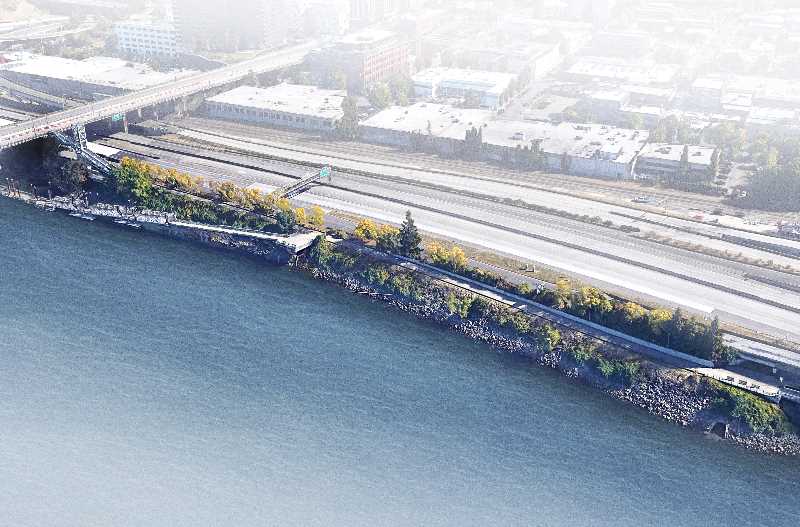PORTLAND, Ore. (Portland Tribune) — The Portland City Council voted Wednesday, Nov. 17, to explore the idea of a new waterfront mini-park on the east bank of the Willamette River between the Burnside and Morrison Bridges.
The council voted to spend $20,000 of its Budget Monitoring Process money on a cost analysis of the plan put forward by the Human Access Project, which has already built beaches and a swimming dock on the river.
Multnomah County is currently working on replacing the Burnside Bridge in the first half of this decade. The Human Access Project’s plan asks for the new bridge to be connected by a ramp to the esplanade for wheeled and pedestrian access. However, current plans only show stairs and an elevator.
Willie Levenson, HAP’s Ringleader, told the Tribune that this part of the esplanade might have large stone steps, like bleachers, leading down to the water. Such terrace designs are popular worldwide, including on the Rhône river in Lyon, France, beside the Marco Polo Tower in Hamburg, Germany, and downtown Boise, Idaho. The rough design calls for new trees and a sound barrier to block out noise from I-5, which is just tens of yards away to the east.
The Human Access Project was behind Poet’s Beach under the west end of the Marquam Bridge and Duckworth Dock, a swimming dock just north of the east end of the Burnside Bridge.
But as Levenson said, with this one, everything rests on the ramp. “If we don’t have a ramp, there’s no point in having a park,” he said.

Willie Levenson, HAP’s Ringleader, told the Tribune that this part of the esplanade might have large stone steps, like bleachers, leading down to the water. Such terrace designs are popular worldwide, including on the Rhône river in Lyon, France, beside the Marco Polo Tower in Hamburg, Germany, and downtown Boise, Idaho. The rough design calls for new trees and a sound barrier to block out noise from I-5, which is just tens of yards away to the east.
The Human Access Project was behind Poet’s Beach under the west end of the Marquam Bridge and Duckworth Dock, a swimming dock just north of the east end of the Burnside Bridge.
But as Levenson said, with this one, everything rests on the ramp. “If we don’t have a ramp, there’s no point in having a park,” he said.

Jan Campbell, the Board President of Disability Rights Oregon and a HAP Board Member, uses a motorized wheelchair to get around. She said she would happily take transit from her west side home to the new Burnside Bridge, then go down a ramp to an accessible park by the water. “There are ways we can get down now, by the Vera (Katz) statue, that’s the way I go. But the elevator is no longer working in the area near where they would build this. Many years ago, there was a working elevator, but it just wasn’t maintained.”
Campbell added that elevators, such as those used by TriMet at Hollywood, are not ideal.
“They break down, people use them for many different things, and they are just not safe.”
She said that the goal is to make the river accessible to more people. A ramp would be ideal for her, but other disabilities would have to be considered. “Ramps can be difficult for people with limited mobility and vision, with skateboards coming down at them. We’d hope there’d be some type of barrier separating pedestrians from other users.”
Commissioner Mingus Mapps, who manages the Bureau of Environmental Services, introduced the amendment to spend the money. Mapps lavished praised the project at the tail end of a council meeting on Nov. 10. “Just $20,000 could be a catalyst for fundamentally reimagining and improving Portland’s Eastbank Esplanade,” Mapps told his fellow councilors. He sold the plan as an accessibility issue, with the ramp making it easy for people in wheelchairs to access the esplanade at this point, and as an environmental one, given that Human Access Project strives to repair natural habitats along the river. “This bridge replacement project is also an opportunity to reimagine our waterfront so that that space is greener,” Mapps said.
He explained that in order to be considered any Federal infrastructure dollars for the project, the city would have to figure out the cost first.
Each agency had its say on who would be responsible for a project involving Environmental, Parks, Transportation, and Multnomah County.
Commissioner Jo Ann Hardesty also supported the cost analysis while warning that her bureau, PBOT, did not have extra money for the bridge. “If anybody’s been up to Vancouver, Washington lately and seen the beautiful waterfront they have, I continue to come back to Portland and say, ‘Why not us?’ This will give us an opportunity to start imagining what life would look like if Portlanders got to enjoy the riverfront and they didn’t have to own an expensive condo in order to enjoy access to the water on a regular basis.”
Hardesty added, “Human Access Project is my hero. They hear no, and they never hear no. They just go and talk to somebody else. This is a great way to spend $20,000 of one-time money.”
Parks Commissioner Carmen Rubio said, “I really love the Human Access Project and all their community-centered work, so I completely support their visioning. I just want to state, too, that it’s a separate thought process than what Parks has been doing, in concert with PBOT and the bridge, but we’re certainly open to seeing where their project visioning leads.”
Wednesday’s vote was part of the fall supplemental budget process, which allocated more than $18 million toward addressing homelessness, $7 million to public safety and $2 million to boost the economy. The money came from a $62 million surplus generated by higher than expected business license taxes.
